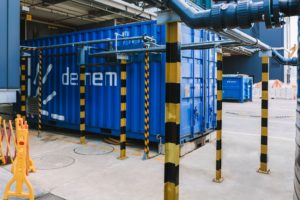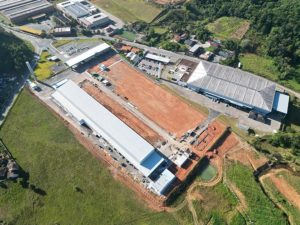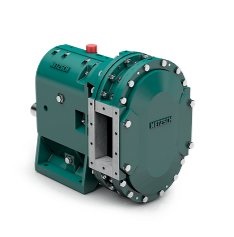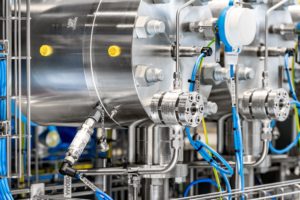Robust Pump from Netzsch Reliably Conveys Highly Abrasive Oil Sand Mixture
Crude oil with a high sand content (up to 30%) is one of the most difficult fluids: The operating conditions such as viscosity, gas content and temperature differ significantly between various oil fields. In context to high differential pressure the sand particles are extremely abrasive.
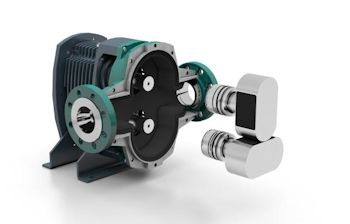
The large front cover can be easily removed and gives open access to the entire pump chamber to facilitate maintenance. The rotary lobes can also be removed individually in just a few steps. (Image: Netzsch)
This results to frequent maintenance or replacement of the pump. Which means high costs for new plants and losses due to downtime. The Tornado T2 rotary lobe pump from Netzsch Pumpen & Systeme GmbH was specifically developed for such demanding operating conditions and is distinguished by a long service life and a high degree of operational reliability. The unique design is also highly compact and ATEX-compliant – two important features for any oil production operation.
To give one example, the T2 has been installed at a plant where the crude oil contains large quantities of sand. The oil is initially pre-treated in a decanter, but the residual sand content is still very high. The mixture therefore has to be pumped into a separator for further processing, where the solids and any water content are separated from the oil. The oil is conveyed at 60° C, whereby the viscosity of the crude oil is between 30 and 35 mm²/s.
Improved robustness thanks to modified combination of materials
The heat and in particular the grains of sand that are up to 1 mm in size put a major strain on any pump system. The T2 series comes with an unusual combination of materials to meet that challenge. Instead of rubber lobes rotating conventionally in a steel housing, Netzsch reverses the materials for the static and dynamic parts. The inner wall is a thin elastomer insert that can be easily taken out and replaced when worn. The housing itself, however, does not have to be removed and can continue to be used. The rubber compound has also been specifically adapted by the manufacturer s experienced application engineers to suit the application. The selected elastomer is very resistant to chemicals and has a low shore hardness – two characteristics that make the material particularly resistant to sand particles.
Two bi-lobe straight rotary lobes made of high-strength special steel rotate within the elastomer cage and withstand the variable rotation forces better and for significantly longer than rubber components. Thin elastomer inserts are only cured onto the edges of the rotary lobes to ensure that steel does not rub against steel when rotating and that there is only a hard-soft contact between the rotary lobes at any time during rotation. The design helps to preserve the material and reduce wear even further. Reversing the material structure increases service life for abrasive media by up to three times.
Greater efficiency and simpler maintenance
The modified structure also improves conveying performance. As elastomers expand at high temperatures, pumps with thick elastomer lobes have to be designed with large clearances to avoid jamming. The thin housing insert of the T2 hardly swells at all, so that the components can be more accurately matched, increasing the efficiency of the pump. For a radial gap to develop, a far greater amount of elastomer would have to be worn away from the whole radial area of the insert that until now would have had to wear away on the tips of the rubber lobe design. In addition, the innovative combination of materials reduces the friction between the components, thereby also reducing the loss of performance. Performance is also improved by the long sealing line between the straight lobes, which reduces backflow, and a large free ball passage that can handle even larger lumps of material without blocking up. Small, pocket-like recesses incorporated into the elastomer insert ensure that pulsation is still as low as in spiral multi-lobe designs, despite the simpler lobe structure.
The lobes are attached with quick clamping elements on the outside of the pump chamber, which helps to keep the pump chamber free of dead space and allows the rotary lobes to be replaced individually without specialist tools in just a few steps. The large front cover can also be easily removed to give free access to the whole of the interior of the pump. The pump can therefore be inspected and cleaned in place for maximum convenience and does not have to be dis-assembled from the line. Installing new lobes is also easier thanks to an integrated rotor positioning device and the special cartridge design of the mechanical seals. The pre-set mechanical seals are easily fitted onto the shaft along with the rotary lobes. The installation space required for all variants – whether single- or double-acting – is the same so that the right seal can be installed for each application.
Belt drive saves space and improves reliability
Besides the conveyor itself, the drive of the T2 has also been optimised for tough environmental conditions, such as prevail in crude oil extraction. The complex timing gear – susceptible to failure and requiring an extensive stock of spare parts – has been replaced by a lean and robust belt drive. A double-toothed elastomer belt transfers the power from the motor to the shafts while simultaneously synchronising the rotary lobes. This double functionality saves space, the more so as the motor can be flange-mounted directly above the pump. The T2 is therefore one of the shortest pump systems on the market. In our above example, the installation dimensions are only 500 x 700 x 800 mm – an important factor for the narrow technical skid the oil company operates at the bore site.
The synchronised gear is also robust in the event of faults or damage. Even if the rotary lobes are blocked, it is only the belt that might skip or tear and the belt can be easily replaced by unscrewing just two screws. With a timing gear, any blockage would have normally resulted in total loss. The combination of soft belt and steel gear wheels also means that entire system runs very smoothly with low vibration, which protects the components and increases their service life. In combination with torsion- and deflection-resistant shafts and robust angular contact ball bearings, the pump therefore has a long life without any reduction in performance. In addition, the drive operates completely without oil, avoiding expensive oil changes and any potential leaks.
ATEX-certified as standard
As the pump is designed to be used to convey oil sand in a class 1 explosive atmosphere, the installation required a corresponding ATEX certificate. The T2 series meets the requirements as standard for zones 1, 21 and M2 at ambient temperatures from -20 to +60 °C and media temperatures up to +100 °C. Thanks to inbuilt ignition protection and liquid immersion, the systems also meet the requirements for non-electrical devices in groups I and II, categories M2, 2G and 2D, as well as IIC.
To install the system in the limited space and with the complex connection requirements for the technical skid of the plant, the Netzsch experts worked closely with the engineers on site to find a connection solution that would suit the operator s system. The T2 has now been in service for more than a year without interruption and conveys between 3 and 12 m³ of the abrasive crude oil sand/water mixture per hour to the downstream separator at a pressure of 2.5 bar.

